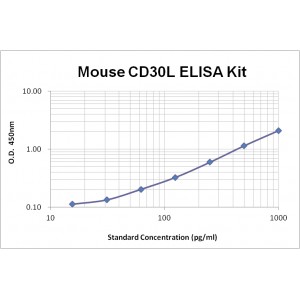More info
Assay Range | 15.6-1,000 pg/mL |
Sensitivity | 6.0 pg/mL |
Size | 96T |
Storage | Store at 2 - 8ºC. Keep reconstituted standard and detection Ab at -20 ºC |
Assay Principle | Sandwich ELISA |
Sample Volume | 100 µL final volume, dilution factor varies on samples |
Detection Method | Chromogenic |
Kit Components
1. Recombinant Mouse CD30L standard: 2 vials
2. One 96-well plate coated withMouse CD30L Ab
3. Sample diluent buffer: 12 mL - 1
4. Detection antibody: 130 µL, dilution 1:100
5. Streptavidin-HRP: 130 µL, dilution 1:100
6. Antibody diluent buffer: 12 mL x1
7. Streptavidin-HRP diluent buffer: 12 mL x1
8. TMB developing agent: 10 mL x1
9. Stop solution: 10 mL x1
10. Washing solution (20x): 25 mL x1
Background
CD30 ligand (CD30L), also known as tumor necrosis factor ligand superfamily member 8 (TNFSF8), or CD153, is a type II membrane protein belonging to the TNF superfamily. CD30L is expressed on activated T cells, B cells, and monocytes. CD30L is a ligand for CD30/TNFRSF8, a type I transmembrane glycoprotein belonging to the TNF receptor superfamily. CD30L/CD30 activation costimulates antigen induced Th0 and Th2 proliferation and cytokine secretion but favors a Th2-biased immune response. In B cells, CD30 ligation promotes cellular proliferation and antibody production in addition to the expression of CXCR4, CCL3, and CCL5. CD30 can activate NF-kappaB signaling by interacting with the adaptor proteins TRAF2 and TRAF5. CD30 has been approved by FDA for use in Hodgkin lymphoma (HL) and Systemic anaplastic large cell lymphoma (sALCL) under some conditions.


